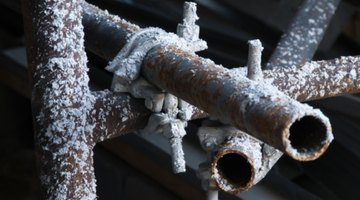How to Repair the Threading on a Pipe
Threads on a pipe are an important mechanism to keep two pipes connected and free of leaks. The threads on the end of a pipe can become damaged and should be repaired to avoid disaster. The material pipes are made of can vary and some metals are easier to repair than others.

For example, copper is softer and more easily repaired than steel. Whatever the material, however, the process is the same.
Things You Will Need
- Pipe vice
- Pipe cutting oil
- Pipe die
- Rag
Tip
The most important part of this repair process is to have the correct pipe die size. Some pipe dies have handles. Those without handles must be turned with a wrench. The harder the metal, the harder you will have to work to repair the threads. You can use this same procedure to establish new threads on a pipe without threads. The end of the pipe must be cut precisely flat.
Warning
Wear gloves and safety glasses for this operation. Metal filings can cut you.
-
Mount the pipe in a pipe vise. It must not move. The pipe should stick out from the vise no more than 12 inches.
-
Wipe the end of the pipe with a clean rag and remove any dirt or debris. Lubricate the end of the pipe with cutting oil.
-
Fit a pipe die over the end of the pipe. It must line up perfectly so the threads can be repaired correctly. If it is not lined up, the threads will be crooked. Turn the pipe die clockwise onto the existing threads one-quarter turn if possible. If the threads are too damaged, this will not be possible.
-
Grasp the handle of the pipe die and turn it clockwise a half-turn. Turn it counterclockwise a quarter turn. Turning back like this will eject any metal filings generated by the die. Wipe away any debris with the rag.
-
Continue the half-turn-clockwise, quarter-turn- counterclockwise procedure until you work the pipe die onto the end of the pipe. It should cover the existing, damaged threads. However, it should not cover more than the width of the pipe die.
-
Turn the pipe die counterclockwise until it comes off the pipe. When it is almost off the pipe, hold it in place so it comes off the pipe straight. You don’t want to damage the new threads.
-
Wipe the end of the pipe with a clean rag. Tap the pipe die on a table to dislodge any metal filings that may still be inside.
The Drip Cap
- Threads on a pipe are an important mechanism to keep two pipes connected and free of leaks.
- The threads on the end of a pipe can become damaged and should be repaired to avoid disaster.
- Wipe the end of the pipe with a clean rag and remove any dirt or debris.
- If it is not lined up, the threads will be crooked.
- Turn the pipe die clockwise onto the existing threads one-quarter turn if possible.
- However, it should not cover more than the width of the pipe die.
References
Writer Bio
Karren Doll Tolliver holds a Bachelor of English from Mississippi University for Women and a CELTA teaching certificate from Akcent Language School in Prague. Also a photographer, she records adventures by camera, combining photos with journals in her blogs. Her latest book, "A Travel for Taste: Germany," was published in 2015.
Photo Credits
- Jupiterimages/Photos.com/Getty Images
- Jupiterimages/Photos.com/Getty Images
More Articles



